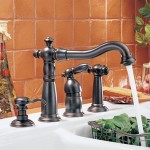I wrote previously about repairing a leaky Delta shower head, so I will show you How to Repair or Fix a Leaking two handle Delta Bathroom Sink Faucet. Once again, I’ve created a pictorial walkthrough.
As before, this is a pretty easy fix. The primary symptom was a consistent drip, drip, drip that not only annoyed us, but also was starting to stain the sink.
Diagnosing the problem
First things first… The faucet in question has two handles — one for hot water and one for cold water. Before attempting a fix, I decided to first narrow down the problem. I first turned off the cold water supply line and watched for drips.
Since the problem persisted, I knew that the hot water handle was leaking. When I turned the cold water supply line back on and shut off the hot water line, the problem stopped.
Voíla! I only needed to take apart the hot water handle. While I could’ve put fresh parts into the cold water handle, I learned long ago to leave well enough alone. Now for the fix…
What you’ll need
1. Allen wrench. In order to get the handle(s) off the faucet, you’ll need an allen wrench to loosen the set screw. As with the shower faucet, our sink faucet required a 3/32 inch allen wrench.
2. Crescent wrench. Once you have the handle off the faucet, you’ll need a wrench to get remove the nut holding the faucet cartridge in place. I used an adjustable crescent wrench.
3. Faucet repair kit. Depending on exactly what’s wrong, you’ll need a faucet repair kit. I picked up the Danco 88101 faucet repair kit, though you may be able to get away with just the seats and springs (Danco 80704). Note that both of these kits give you enough parts to fix both handles if necessary.
Disassembling the Dalta Bathroom Sink faucet
First things first. Before you start taking things apart, be sure to turn off the water supply lines. In most cases, you can access the shutoff valves from underneath the sink.
Once the water is off, you’re ready to fix that leak. Pictured below is our faucet prior to disassembly.
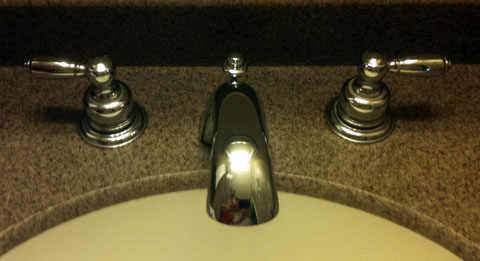
And here’s a closeup of the hot water handle. The red arrow points to the set screw in the base of the handle. Use your allen wrench to loosen the set screw and remove the handle.
Next, you’ll need to remove the large nut that holds the faucet cartridge in place. In the picture below, I’ve already taken it off (it goes on over the brass threads).
Once the nut is off, look carefully at how the cartridge is situated. You might even want to snap a picture so you can put everything back together properly.
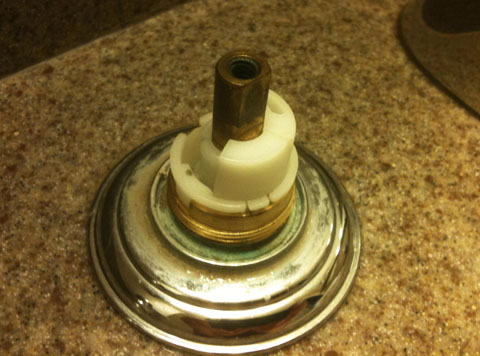
Okay, now it’s time to pull that cartridge out. Be patient and just wiggle it back and forth while pulling up on the stem. If you can’t get it out, you might need to (gently) work on it with a flathead screwdriver. Just be careful not to damage anything.
Once the cartridge is out, look down inside the handle. You might have to sop some water out, but at the bottom you will see two holes. Sitting in the larger hold will be a spring and a rubber seat. Pull out both the spring and the seat, as this is likely where your leak is coming from.
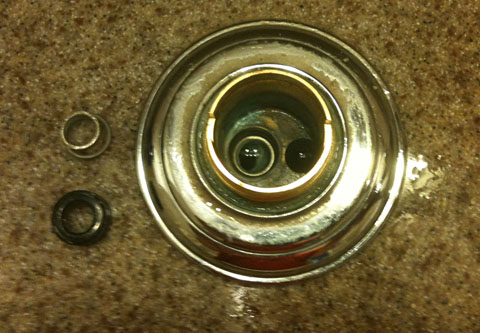
If you want to just replace the spring and seat, do so now and then re-assemble. If you want to do a more thorough job (and you have the faucet repair kit), then read on…
Opening the sink faucet cartridge
The picture below shows what the faucet cartridge looks like after it has been removed and dis-assembled. To get it open, simply separate the two halves.
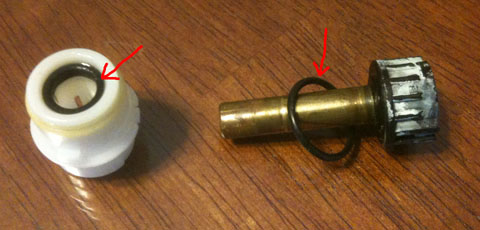
Now that you have it apart, you can easily replace the two “O” rings. There are several sizes in the repair kit. Simply choose the right one, replace the old with new, and re-assemble.
And now… Just reverse the steps to get things back together.
Faucet repair notes
A few notes to go along with the above instructions.
First, as noted above, the cartridge might not come out easily. If you can’t get it out by rocking it back and forth while pulling, you might have to gently pry it loose.
Second, I had a bit of trouble getting the new rubber seat into the hole in the base of the handle. If this happens, just be patient. You might also be able to improve the situation by poking the edges in with a small flathead screwdriver.
Finally, note that the spring/seat will push up on the cartridge, such that you’ll have to hold it down while you screw the nut back on. This is a good thing, as you want that rubber seat pressed tightly against the cartridge.

